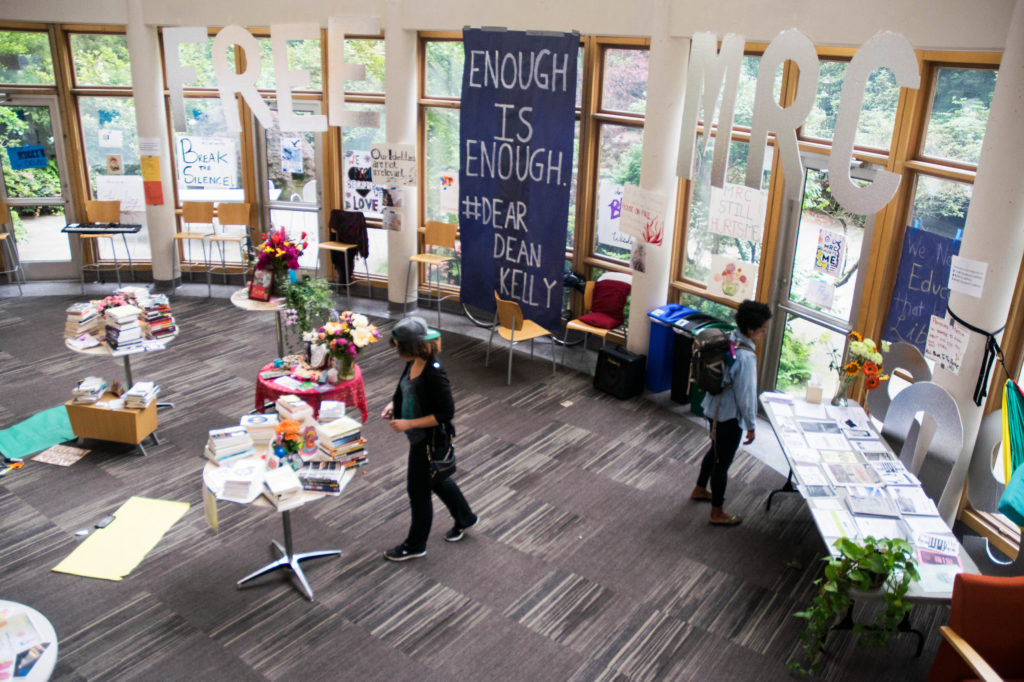On a wall in the Matteo Ricci office now hangs a frame containing four photographs and a note written on a small piece of paper. The photos show a group of students standing in the Casey Atrium and the entrance of the MRC office.
The note reads: “From May 11 to June 3 of 2016, a group of MRC students and their allies held this space to demand an education that leads to liberation. This message and these photos remain to document their efforts, honor the work of people who came before them and to offer future generations a foundation to create their own change.”
This group is known as the MRC Student Coalition. As the note explains, they staged a demonstration last year in which they occupied the MRC office and most of the first floor of the Casey building for approximately 24 days.

The lobby of the Casey building after 2 weeks of being occupied by the Coalition.
They did so for many reasons. Foremost, the coalition called for the immediate resignation of Jodi Kelly, former dean of the Matteo Ricci College. Kelly was allegedly responsible, along with other members of the faculty and administration, for practicing and maintaining a culture of racism, sexism and white supremacy in the college itself. The coalition relied on personal anecdotes and individual testimony to support this claim.
The coalition also demanded that the curriculum be revised to prioritize voices of color and otherwise marginalized people, rather than focus on the narratives of old, white men.
As the sit-in continued, people came forward with new information. MRC faculty members testified in front of Academic Assembly and shared experiences in which they felt “bullied, intimidated and silenced” by the leadership. Soon, what began as an honest act of civil protest came to reveal long withstanding violations of academic liberty and instances of intimidation and job insecurity in the college.
Meanwhile, support for the coalition grew. Letters of solidarity came from campus groups like the career services staff, the Ignatian Leaders Cohort and the Center for Community Engagement, among others. Off campus, letters came from University of Washington, Seattle Pacific University and Seattle Central Community College.
The coalition received its fair share of criticism, too. Arthur Fisher, former dean of the Matteo Ricci College, wrote a letter to the Spectator in which he referred to the coalition as a “lynch mob” and condemned their claim that Dean Kelly is racist. Many MRC students voiced their opposition to the coalition by testifying in front of Academic Assembly and through interviews with the Spectator.
Local newspapers like The Seattle Times, the Seattle Globalist and the Stranger frequently covered the events in a moderate way. Other publications were not so kind, and launched heavy criticism at the students for making such steep demands, and the administration for giving in to them.
In an article published in the Wall Street Journal, Jonathan Marks wrote: “If we resist the urge to pronounce the protesters insane and the administrators craven, we might ask whether student activists are right that even the most liberal campuses in America are bastions of prejudice.”
A story in the New Yorker echoed similar remarks, joining the ranks of baby boomers who criticize millennials for demanding “safe spaces” and avoiding any idea or thought that could be considered controversial.
Regardless, the coalition got most of what it wanted. On June 1, President Fr. Stephen Sundborg, S.J., sent an email announcing the retirement of Jodi Kelly and her appointment to emeritus faculty. Paulette Kidder, associate professor of philosophy in the College of Arts and Sciences, Coalition members took this as a momentary victory. In July, Sundborg announced the appointment of Natasha Martin, J.D., Associate Professor of Law, as the Associate Vice President for Institutional Inclusion and Chief Diversity Officer. In August, Interim Provost Bob Dullea announced the formation of the MRC Strategic Planning Task Force, a group of ten faculty members, eight students and alumni and one member of the Seattle Prepazratory faculty. The purpose of the task force is to assess the curriculum, operations and culture of the college.
“The Provost’s office and Interim Dean Kidder are continuing to work with students, faculty and others to move forward on the commitments we share,” Sundborg wrote in a statement to the Spectator. “We will need every college, school and non-academic unit working collaboratively in support of these efforts to realize our aspirations.”
This Thursday, September 29, all MRC students have been invited to attend a workshop called “Seeing the Water: Racial Dynamics in Daily Life.” Presumably, this is a response to what happened in the college last year.
The author may be reached at
nturner@su-spectator.com







